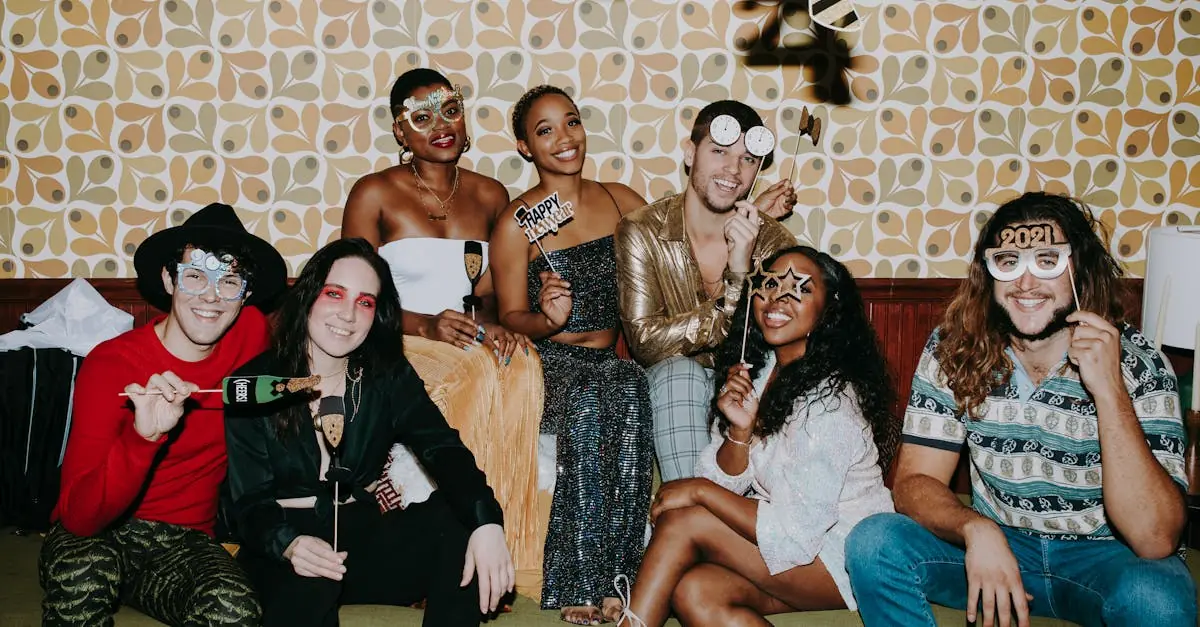Gen Z is flipping the script on fashion and culture, diving headfirst into the nostalgic pool of retro trends. From vibrant 90s windbreakers to the quirky charm of early 2000s pop culture, they’re reclaiming styles that once defined their parents’ youth. It’s like they’ve time-traveled to raid a thrift store, and honestly, who can blame them? Vintage is in, and the younger generation is rocking it with a flair that’s hard to ignore.
Table of Contents
ToggleOverview of Gen Z Retro Trends
Generation Z actively embraces retro trends, turning to the bold styles of the 1990s and early 2000s for inspiration. Thrift stores serve as popular hunting grounds, offering a treasure trove of vintage clothing and accessories. Fashion choices include oversized denim jackets, baggy jeans, and crop tops, which reflect the carefree vibe of these iconic decades.
Iconic brands like Tommy Hilfiger and FUBU are making a significant comeback, appealing to young consumers. Many Gen Z individuals curate their wardrobes by mixing and matching these retro pieces with contemporary items, creating unique outfits that stand out. Music also plays a key role in this resurgence, as artists from those eras gain popularity on platforms like TikTok.
Footwear trends highlight the return of chunky sneakers and platform shoes, which add a nostalgic touch to modern looks. Accessories like bucket hats, butterfly clips, and colorful scrunchies round out this retro aesthetic, offering a playful edge to any ensemble.
Social media greatly influences these trends, where fashion influencers showcase their vintage finds and inspire followers to embrace similar styles. Notably, the desire for sustainable fashion drives Gen Z’s inclination towards vintage shopping. Embracing nostalgia, they celebrate individuality and creativity through reclaimed styles, giving classic pieces renewed life and relevance.
The fusion of retro elements with modern sensibilities illustrates Gen Z’s unique approach to fashion. Each trend reflects their cultural identity and willingness to reinterpret the past in a fresh and exciting way.
Popular Retro Trends Among Gen Z
Generation Z showcases a dynamic embrace of retro trends, reflecting a love for nostalgia interwoven with modern influences.
Fashion Trends
Vintage clothing defines Gen Z’s fashion choices. Oversized denim jackets and baggy jeans prominently feature in daily outfits, embodying a laid-back style from the ’90s and early 2000s. Crop tops also see extensive use, allowing for playful layering with contemporary pieces. Iconic brands like Tommy Hilfiger and FUBU experience a resurgence, appealing to this cohort’s desire for authenticity. Chunky sneakers and platform shoes serve as popular footwear options, enhancing outfits with bold statements. Accessories like bucket hats and colorful scrunchies bring a whimsical touch. Thrift shopping remains a favored activity, as it aligns with their values of sustainability and individuality.
Music and Art Influences
Music from past decades significantly impacts Gen Z’s cultural expression. Platforms like TikTok propel ’90s and early 2000s tracks into mainstream consciousness, with viral challenges often using iconic songs. Artists sampling retro sounds create a bridge between generations, allowing new listeners to enjoy classic hits. Art also reflects this trend, with retro aesthetics influencing digital content and physical art forms. Bright colors and playful designs mimic styles prevalent during those iconic eras. Social media plays a crucial role in spotlighting these influences, as influencers curate content that celebrates vintage music and art movements, fostering a rich cultural dialogue.
Impact of Social Media on Gen Z Retro Trends
Social media significantly influences how Generation Z embraces retro trends, showcasing styles from the 1990s and early 2000s. The online landscape provides a platform for nostalgia while offering innovative avenues for expression.
Platforms Shaping Trends
TikTok and Instagram prove influential in shaping Gen Z’s fashion realm. Viral challenges on TikTok spotlight outfits that revive past styles, attracting widespread attention. Instagram serves as a visual gallery, showcasing curated looks that blend vintage pieces with modern flair. Users frequently follow hashtags like #Y2K and #90sFashion, leading to greater visibility for retro items. Pinterest acts as a source of inspiration, allowing users to discover and save looks that resonate. Each of these platforms fosters a community where sharing and discovering retro trends becomes integral to fashion evolution.
Influencers and Their Role
Influencers play a pivotal role in promoting retro fashion among Gen Z. Popular creators often showcase how to style vintage items, making them appealing and accessible. Followers connect with them through authentic content that celebrates unique fashion choices. Influencers also partner with brands to highlight retro collections, driving consumer interest and engagement. Collaborations with established retro labels amplify their reach, connecting various audiences. The engagement between influencers and their followers creates a vibrant dialogue around nostalgia, further solidifying retro trends within Gen Z’s culture.
Nostalgia and Its Significance
Nostalgia plays a crucial role in the cultural identity of Generation Z. It reflects their desire to connect with the past, particularly the vibrant styles of the 1990s and early 2000s. This yearning often manifests through fashion choices, music preferences, and creative expressions.
Vintage aesthetics resonate deeply with this generation, providing a sense of comfort and familiarity. Elements such as oversized denim jackets and crop tops evoke cherished memories, allowing individuals to curate unique styles that tell their stories. These clothing items serve as markers of identity, showcasing personal and collective narratives.
Music from earlier decades also enriches Gen Z’s cultural landscape. Tracks from the ’90s and early 2000s re-emerge on platforms like TikTok, bridging generational gaps. Engaging with these songs encourages a deeper appreciation for the artistry of past artists while connecting young listeners with their heritage.
Social media amplifies this nostalgic revival, enabling users to discover and share retro trends effortlessly. Viral challenges featuring iconic tunes and vintage styles generate conversations about what it means to embrace the past. This engagement fosters a community that celebrates shared experiences through curated content.
Sustainability intertwines with nostalgia as thrift shopping becomes a favored pastime. Buying second-hand items allows Gen Z to adopt retro styles while being environmentally conscious. Each thrift store visit unveils a treasure trove of fashion history, encouraging the joy of rediscovering forgotten trends.
Art also embodies nostalgic themes, with bright colors and playful designs reflecting past movements. This visual language captivates audiences, inviting them to engage with creative interpretations of well-loved styles. Through digital content and physical art forms, nostalgia continues to shape cultural expression within Gen Z.
Generation Z’s embrace of retro trends showcases a vibrant blend of nostalgia and modernity. By curating styles from the past, they breathe new life into iconic fashion and cultural expressions. Their love for vintage aesthetics not only reflects a desire for individuality but also aligns with values of sustainability.
Through platforms like TikTok and Instagram, Gen Z amplifies these trends, connecting with their peers while celebrating shared cultural experiences. As they mix retro pieces with contemporary styles, they redefine what it means to be fashionable today. This unique approach to fashion and culture demonstrates their ability to honor the past while confidently stepping into the future.



